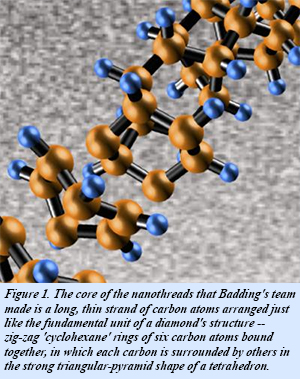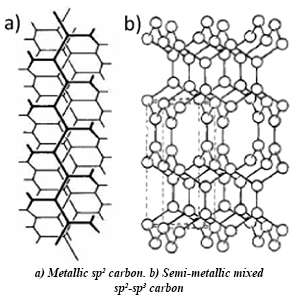 Goal: To stabilize and characterize new forms of carbon through tailored synthetic processes for the development of new structural materials.
Goal: To stabilize and characterize new forms of carbon through tailored synthetic processes for the development of new structural materials.Personnel: John Badding (Lead), Vincent Crespi, Nasim Alem, Reinhard Boehler, Timothy Strobel, Russell Hemley, Roald Hoffmann, Neil Ashcroft, Kai Landskron, Malcolm Guthrie
Project Documents: EFree Papers, Relevant Publications, Progress Reports

We now have the opportunity to potentially develop whole new families of low dimensional carbon nanomaterials. For example, kinetically controlled synthesis starting from aromatic molecules containing heteroatoms (e.g., pyridine) or substituents (e.g., halobenzene) will tune electronic properties and introduce new reactive sites for further chemical modification. These materials are simply not accessible with traditional synthetic capabilities (e.g., conventional high-temperature gas phase synthesis methods). These limitations are overcome by using the new cold compression approach.
Key milestones are to identify the atomic level structure of nanothreads and determine the chemical reaction pathway for the formation of nanothreads under pressure using in-situ advanced x-ray and neutron characterization techniques, first principles modeling, and chemical theory.

We also plan to increase quantities of nanothreads that can be synthesized by developing new large-volume high-pressure apparatus and also use dopant and photocatalytic means to reduce reaction pressures (guided by first principles computation). Ultimately, we seek design rules for kinetically controlled synthesis using solid state steric constraints for a broad new class of low dimensional carbon materials, especially those that have low dimensionality and sp3 or mixed sp2/sp3 bonding. These materials may have not only exceptional mechanical properties, but electronic properties useful for energy applications such as tunable band gaps.
